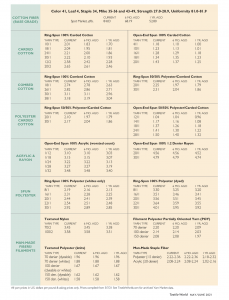 By Jim Phillips, Yarn Market Editor
By Jim Phillips, Yarn Market Editor
N四分之三的制造商和distribu早期tors are optimistic about their business prospects in the next six months, according to a new industry report from Sikich LLP, a global company specializing in technology-enabled professional services. Seventy-two percent of respondents ranked their level of optimism at a seven or higher, on a scale of one to 10, in Sikich’s Industry Pulse: Manufacturing and Distribution. The survey also found that more than half of manufacturers and distributors are looking to expand their workforce in the next six months.
Sikich’s report is well in line with the recent optimism shown by spinners and others in the U.S. textile industry. “It been a dark time — especially at the start,” said one executive about the global COVID-19 pandemic. “But, beginning mid-year or so last year, things began to pick up, and we were able to salvage many of our initial goals. Now, with an ever-increasing number of vaccinations, Americans are beginning to get on the move again. And that has translated into a significant uptick in business.
“As the world slowly opens back up, manufacturers have a lot to look forward to,” said Jerry Murphy, partner-in-charge of Sikich’s manufacturing and distribution team. “This past year has showcased the resilience of the manufacturing industry. From quickly implementing safety protocols in their facilities to maintaining production in a fast-changing environment, manufacturers impressively adapted throughout the past year. Having
navigated a tumultuous 2020, the industry appears primed for growth.”
High-Tech Textiles Gain Momentum
Nanotechnology is among the more notable advances aimed at creating new and more diverse fibers for various uses in both high-technology applications and everyday fabrics. Nanotechnology deals with dimensions and tolerances of less than 100 nanometers, especially the manipulation of individual atoms and molecules.
Nanotechnology is being used to impart certain aspects to natural fibers, such as antimicrobial properties, self-cleaning properties and enhanced durability. Such textiles are being increasingly adopted by sectors such as medical apparel. Nanotechnology is also being used to develop natural alternatives to artificial fibers. For instance, graphene-strengthened natural jute fiber composites have high strength and durability. This trend is expected to have a strong influence on textile product mills, especially in North America and Europe.
In the healthcare industry, fabrics can be created for use in drug delivery and the healing of wounds. Silver nanoparticles, according to an article by Dr. Priyom Bose, who holds a Ph.D. in Plant Biology and Biotechnology from the University of Madras, India, can be used in products for burn dressings and scalds. They can also be used to screen heart rate, body temperature and breathing rhythm.
Further, Bose said, nano-fibers provide a high degree of resistance to extreme temperatures, are durable, embedded with antibacterial properties and can include multipurpose nano-sensors. These attributes make them valuable for various military applications.
Market research firm Technavio has recently released a report on the “E-textile Market by End-user and Geography – Forecast and Analysis 2020-2024.”
According to the report, the electronic textiles market is poised to grow by $1.85 billion between 2020-2024, progressing at a CAGR of over 18 percent during the forecast period.
The demand for health-monitoring wearables is one of the key drivers of the e-textile market, which helps vendors improve their market position. Moreover, this market report also provides information on the competencies and capacities of the leading vendors along with the details of the product they offer. Technavio says that factors such as demand for health-monitoring wearables will help companies create strategies to make the most of future growth opportunities.
The firm projects that 37 percent of the market’s growth will originate from North America during the forecast period. The United States and Canada are the key markets for the e-textile market in North America. The E-textile market’s growth in this region can be attributed to the rising number of lifestyle diseases. According to the company key market drivers are high demand for health-monitoring wearables, the rising number of lifestyle diseases and increased awareness of healthy lifestyle.
May/June 2021





